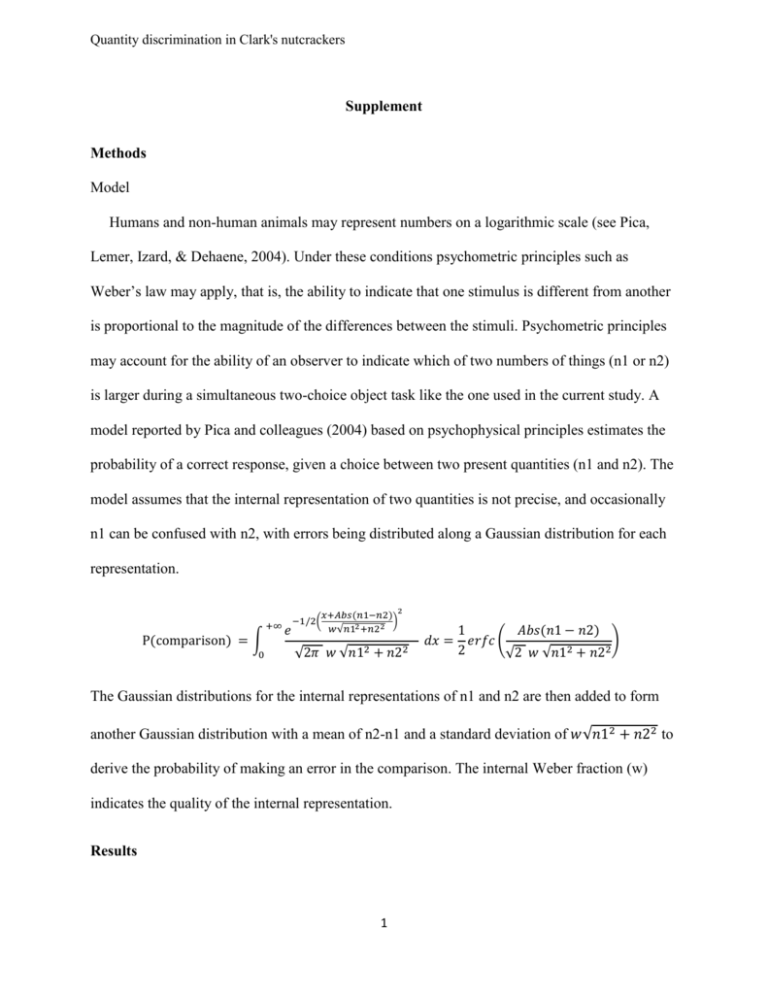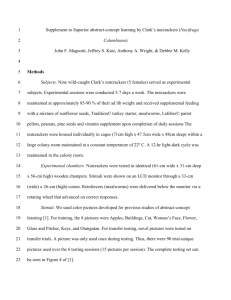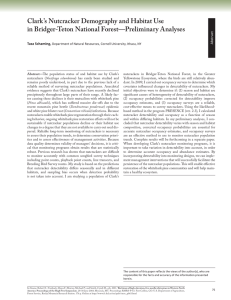COMTornick20130266F1
advertisement

Quantity discrimination in Clark's nutcrackers Supplement Methods Model Humans and non-human animals may represent numbers on a logarithmic scale (see Pica, Lemer, Izard, & Dehaene, 2004). Under these conditions psychometric principles such as Weber’s law may apply, that is, the ability to indicate that one stimulus is different from another is proportional to the magnitude of the differences between the stimuli. Psychometric principles may account for the ability of an observer to indicate which of two numbers of things (n1 or n2) is larger during a simultaneous two-choice object task like the one used in the current study. A model reported by Pica and colleagues (2004) based on psychophysical principles estimates the probability of a correct response, given a choice between two present quantities (n1 and n2). The model assumes that the internal representation of two quantities is not precise, and occasionally n1 can be confused with n2, with errors being distributed along a Gaussian distribution for each representation. P(comparison) = ∫ 0 𝑥+𝐴𝑏𝑠(𝑛1−𝑛2) 2 +∞ −1/2( 𝑤√𝑛12 +𝑛22 ) 𝑒 √2𝜋 𝑤 √𝑛12 + 𝑛22 1 𝐴𝑏𝑠(𝑛1 − 𝑛2) 𝑑𝑥 = 𝑒𝑟𝑓𝑐 ( ) 2 √2 𝑤 √𝑛12 + 𝑛22 The Gaussian distributions for the internal representations of n1 and n2 are then added to form another Gaussian distribution with a mean of n2-n1 and a standard deviation of 𝑤√𝑛12 + 𝑛22 to derive the probability of making an error in the comparison. The internal Weber fraction (w) indicates the quality of the internal representation. Results 1 Quantity discrimination in Clark's nutcrackers Table S1. Number of correct responses (choosing the larger quantity) for each bird during for each condition. Condition Sony Puck Starr Betsy Susan Total Total Effect number % size correct correct number number number number number correct correct correct correct correct out of 8 out of 8 out of 8 out of 8 out of 8 1v2 8 7 8 7 4 34 85 0.770 1v3 6 7 5 6 5 29 72.5 0.836 1v4 8 7 8 7 8 38 95 0.978 1v5 7 8 8 6 7 36 90 0.950 2v3 6 7 6 6 3 28 70 0.598 2 out of 40 Quantity discrimination in Clark's nutcrackers 2v4 7 8 4 7 5 31 77.5 0.687 2v5 6 7 6 3 7 29 72.5 0.612 3v4 5 6 7 5 2 25 62.5 0.395 3v5 8 7 4 7 6 32 80 0.746 3v8 7 8 4 6 7 32 80 0.746 4v5 6 7 3 5 4 25 62.5 0.413 4v6 8 7 7 7 7 36 90 0.981 4v8 4 6 7 7 7 31 77.5 0.766 5v6 3 7 6 5 7 28 70 0.547 6v7 6 7 7 6 5 31 77.5 0.881 3 Quantity discrimination in Clark's nutcrackers 6v8 5 5 7 5 6 28 70 0.816 6v9 7 8 5 6 5 31 77.5 0.784 6v12 6 4 6 6 3 25 62.5 0.447 8v9 5 4 6 4 4 23 57.5 0.429 8v10 5 8 4 5 7 29 72.5 0.612 8v16 7 7 6 6 7 33 82.5 0.958 Total % 77.4 84.5 73.8 72.6 69.0 correct 4 Quantity discrimination in Clark's nutcrackers Table S2. Number of responses for each bird for each condition of the Number, Volume, and Area comparison tests. W = whole pine nuts, H = half pine nuts, S = small array of nuts (~ 5mm spacing), L = large array of nuts (~ 3cm spacing). Sony Puck Starr Betsy Susan number number number number number larger larger larger larger larger out of 8 out of 8 out of 8 out of 8 out of 8 Total Total Effect number % size -0.545 larger out of 40 Number controls 1Wv2H 4 1 2 4 3 14 35 2Wv4H 3 1 3 2 3 12 30 0.784 3Wv6H 5 1 4 2 4 16 40 -0.326 Total % 50 12.5 37.5 33.3 41.7 larger number Volume controls 1Wv1H 7 8 7 7 8 37 92.5 0.980 2Wv2H 8 8 7 8 5 7 38 95 0.978 Quantity discrimination in Clark's nutcrackers 3Wv3H 7 8 6 8 7 36 90 0.938 Total % 91.7 100 83.3 95.8 91.7 larger volume Area controls 2Sv2L 2 2 3 3 2 12 30 -0.840 3Sv3L 3 3 3 3 6 18 45 -0.206 4Sv4L 5 3 3 6 4 21 52.5 0.108 Total % 41.7 33.3 37.5 50 Larger area 6 50










